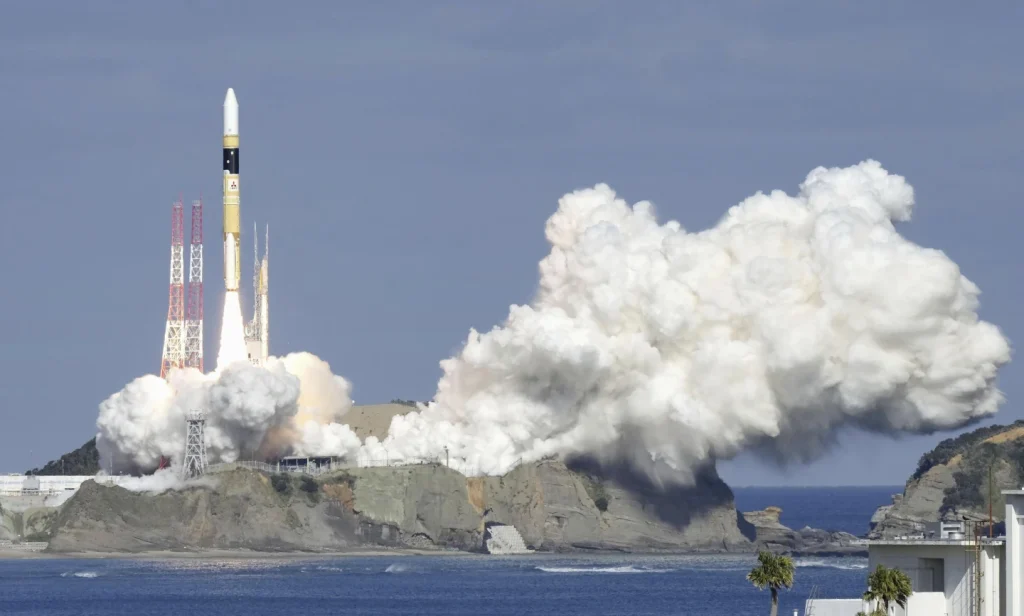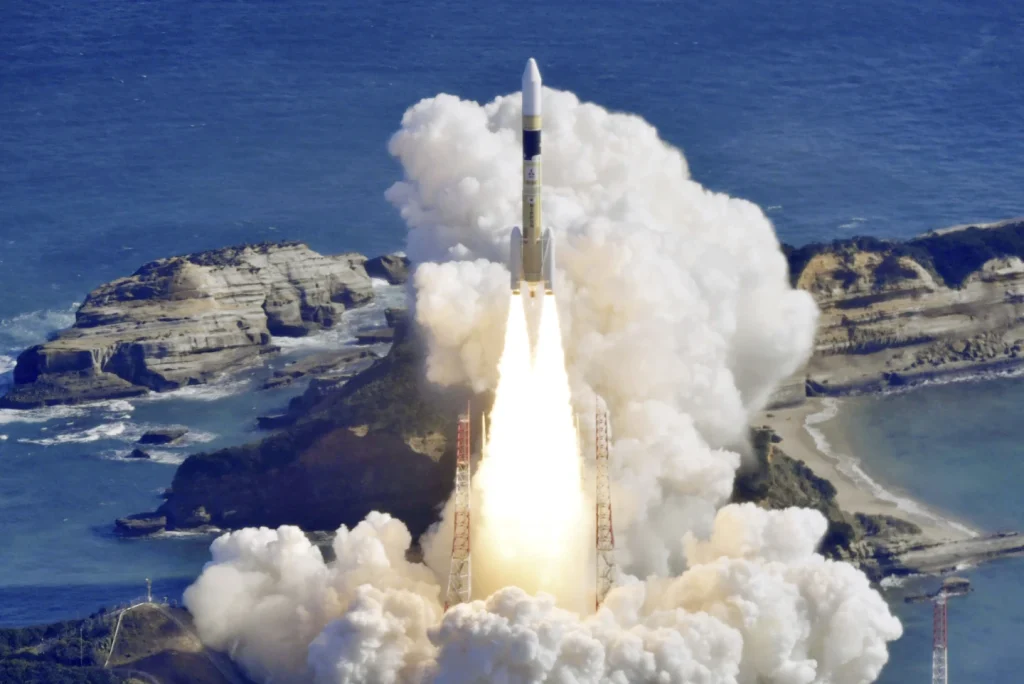Japan’s recent launch of a government intelligence-gathering satellite marks a significant step in the country’s efforts to enhance its military capabilities and improve its ability to respond to natural disasters.
The rocket, an H2A launched by Mitsubishi Heavy Industries Ltd., successfully carried the optical satellite into space from the Tanegashima Space Center in southwestern Japan.
The primary objective of this mission is to monitor movements at military sites in North Korea, a country that has long been a source of concern for Japan due to its aggressive stance and development of nuclear weapons.
By deploying a satellite capable of capturing images even in severe weather conditions, Japan aims to bolster its reconnaissance capabilities and gain valuable intelligence on potential threats from its neighboring country.
In addition to its military applications, the satellite will also play a crucial role in Japan’s disaster response efforts.
The ability to quickly and accurately assess the impact of natural disasters such as earthquakes and typhoons is essential for coordinating effective relief operations and ensuring the safety of the affected population.
With its advanced imaging capabilities, the satellite will provide valuable data that can aid in disaster management and response.
The decision to launch this intelligence-gathering satellite is a reflection of Japan’s commitment to strengthening its national security and disaster preparedness.
The country’s efforts to build a network of 10 satellites for early warning of possible missile launches demonstrate its proactive approach to addressing security challenges in the region.
The origins of Japan’s intelligence-gathering satellite program can be traced back to a pivotal event in 1988, when a North Korean missile flew over Japanese territory, prompting the government to recognize the need for improved surveillance and early warning systems.
Since then, Japan has made significant strides in developing its space capabilities and leveraging satellite technology for national security purposes.
The successful launch of the government intelligence-gathering satellite represents a milestone in Japan’s space program and a testament to the country’s technological prowess.
It underscores Japan’s determination to safeguard its national interests and contribute to regional stability through advanced surveillance and reconnaissance capabilities.
As Japan continues to expand its space-based capabilities, it is poised to play a more prominent role in regional security and disaster response efforts.
The deployment of advanced satellites for intelligence-gathering and monitoring purposes will not only enhance Japan’s defense posture but also contribute to the broader goal of promoting peace and stability in the Asia-Pacific region.
In conclusion, Japan’s recent rocket launch carrying a government intelligence-gathering satellite signifies a significant advancement in the country’s efforts to bolster its military capabilities and improve its disaster response capabilities.
The satellite’s advanced imaging capabilities will enable Japan to effectively monitor military activities in North Korea and enhance its ability to respond to natural disasters.
This development underscores Japan’s commitment to leveraging space technology for national security and disaster preparedness, and it heralds a new era of enhanced surveillance and reconnaissance capabilities for the country.
Prime Minister Fumio Kishida’s government has recently made a significant decision to adopt a national security strategy that includes the deployment of long-range U.S.-made Tomahawk and other cruise missiles.
This move represents a departure from Japan’s long-standing principle of exclusively self-defense, marking a significant shift in the country’s defense posture.
The decision to bolster Japan’s strike capability comes in response to the rapid advancements in weapons technology in neighboring countries, particularly China and North Korea.
The decision to deploy long-range missiles is a bold and controversial move that has sparked debate and raised concerns both domestically and internationally.
On one hand, proponents argue that Japan needs to enhance its military capabilities in the face of growing security threats in the region.
They point to China’s increasing assertiveness in the East China Sea and the South China Sea, as well as North Korea’s continued development of nuclear and ballistic missile programs, as reasons for Japan to strengthen its defense capabilities.
Moreover, proponents of the deployment of long-range missiles argue that Japan’s current defense posture is outdated and inadequate to effectively respond to modern security challenges.
They argue that Japan’s reliance on the U.S. for its security needs is not sufficient, and that the country needs to take a more proactive approach to ensure its own security and defense.
On the other hand, opponents of the decision express concerns about the potential consequences of Japan’s shift towards a more offensive military posture.
They argue that deploying long-range missiles could escalate regional tensions and trigger an arms race in the region.
Furthermore, they worry that Japan’s move could undermine its longstanding commitment to pacifism and non-aggression, as enshrined in its postwar constitution.
In addition, there are concerns about the impact of Japan’s decision on its relations with neighboring countries, particularly China and South Korea.
The deployment of long-range missiles is likely to further strain Japan’s already tense relations with these countries, and could potentially destabilize the region.
The decision to deploy long-range missiles also raises questions about Japan’s commitment to nuclear non-proliferation and disarmament.
While Japan has long been a staunch advocate for nuclear disarmament, the deployment of long-range missiles could be seen as a step towards acquiring offensive capabilities, which could have implications for the global non-proliferation regime.
In conclusion, the decision by Prime Minister Fumio Kishida’s government to deploy long-range U.S.-made Tomahawk and other cruise missiles represents a significant departure from Japan’s traditional defense posture.
While proponents argue that the move is necessary to address growing security threats in the region, opponents express concerns about the potential consequences and implications of Japan’s shift towards a more offensive military posture.
The decision is likely to have far-reaching implications for Japan’s security, its relations with neighboring countries, and its commitment to nuclear non-proliferation and disarmament.
As such, it is a decision that warrants careful consideration and deliberation, both domestically and internationally.
The upcoming liftoff scheduled for Friday has garnered significant attention, particularly in light of the impending launch of the new flagship H3 rocket, which has been developed through a collaborative effort between Mitsubishi Heavy and the Japan Aerospace Exploration Agency (JAXA).
This innovative rocket is poised to succeed the H2A, and its maiden test flight, which unfortunately ended in failure last year, has only served to amplify the anticipation surrounding this momentous event.
The H2A rocket, which is operated by Mitsubishi Heavy and utilizes liquid fuel in conjunction with two solid-fuel sub-rockets, has notably achieved an impressive record of 41 consecutive successes following a setback in 2003.
This remarkable track record underscores the reliability and proficiency of the H2A, boasting an enviable 98% success rate that speaks volumes about its operational prowess and technological advancements.
The development and impending launch of the H3 rocket represent a significant milestone in the realm of aerospace engineering and space exploration.
As the successor to the esteemed H2A, the H3 is poised to embody a new era of innovation, precision, and capability, thereby carrying the weight of high expectations and aspirations for the future of space exploration.
The collaborative efforts between Mitsubishi Heavy and JAXA underscore the profound dedication and expertise that have been channeled into the development of the H3 rocket.
This endeavor represents a testament to the unwavering commitment to pushing the boundaries of technological advancement and achieving new heights in the realm of space exploration.
The upcoming liftoff serves as a pivotal moment that will not only mark the commencement of a new chapter in the evolution of rocket technology but will also symbolize the culmination of tireless research, development, and testing.

The anticipation and scrutiny surrounding this event are palpable, as stakeholders and enthusiasts alike eagerly await the outcome of this historic launch.
The resounding success of the H2A rocket has undoubtedly set a high standard for the H3, and the collective hopes and aspirations vested in this new flagship rocket are indicative of the profound impact it is poised to have on the landscape of space exploration.
The lessons learned from past endeavors, coupled with the relentless pursuit of excellence, have undoubtedly contributed to the meticulous design and preparation of the H3 rocket, instilling confidence in its potential to carve out a legacy of its own.
As the countdown to Friday’s liftoff draws nearer, the world will bear witness to a moment that encapsulates the spirit of human ingenuity, perseverance, and ambition.
The culmination of years of research, development, and collaboration will converge in a spectacle that transcends national borders and unites individuals in a shared sense of wonder and awe.
In conclusion, the impending liftoff of the H3 rocket represents a testament to the indomitable human spirit and the relentless pursuit of progress.
It symbolizes the culmination of unwavering dedication, expertise, and innovation, and serves as a beacon of hope for the future of space exploration.
The world eagerly awaits the outcome of this historic event, as it stands poised to usher in a new era of possibilities and discoveries.
